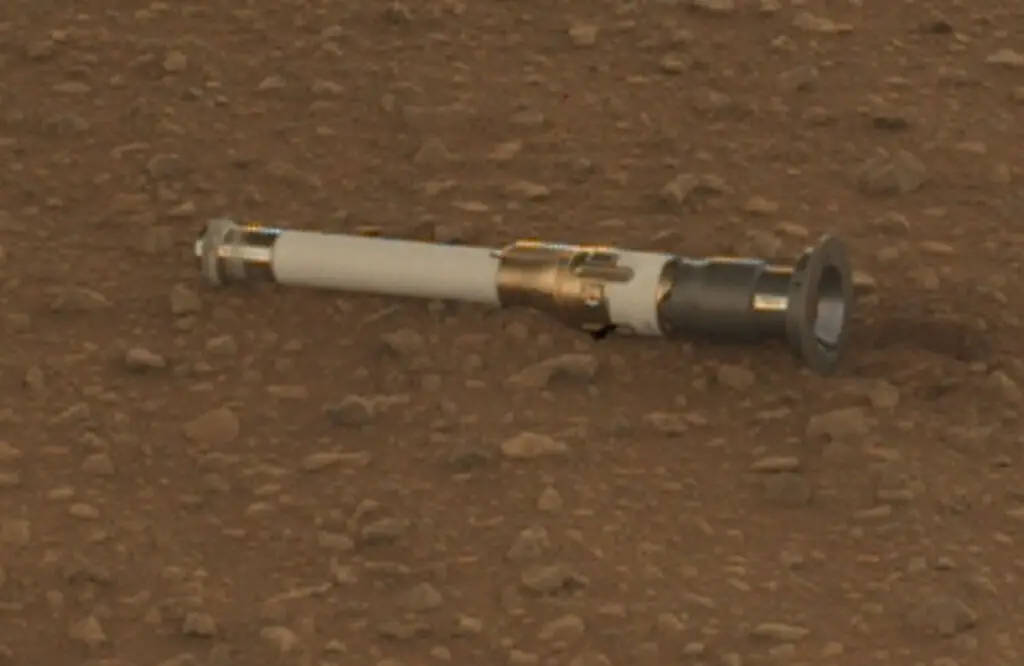NASA’s Perseverance rover just dropped its first rock sample on the Martian terrain at a region where future mars missions will pick up the precious rock samples and return them back to Earth. NASA released a statement on Wednesday (December 21), detailing how this rock sample will help to advance the search for life on Mars.
Since the rover landed on Mars in February 2021, it has been exploring Mars in search of ancient life on the red planet. NASA’s Jet Propulsion revealed in a recent update that the rover has continuously focused on searching for ancient microbial life in an old river delta. The rover will collect about 10 titanium tubes deposited in this region of Mars.
NASA is already working towards collecting these Mars samples in the 2030s. The American Space Agency is hoping to use two helicopters that are similar to the currently flying Ingenuity Mars Helicopter to fly down to Jezero Crater on Mars and collect the rocky tubes before commencing with the return mission to Earth. Rock samples kept in the Jezero Crater are referred to as the backup depot.
NASA Perseverance control team instructed the rover to gather twin samples and deposit them at the old river delta and Jezero Crater respectively for pickups. The rover uses a set of caches installed inside it to deliver these rock samples to the planned locations. When it is time for pick-ups and NASA could not reach the main pick-up location, the helicopters could be controlled to pick up the back tubes from the second location and ensure that the goal of the mission is accomplished.
How NASA plans to Return the Rock Samples to Earth.
While the Perseverance rover is working on delivering the twin rock samples at two locations, NASA will only return samples from one location. The two helicopters will fly down to the targeted site and pick up the tubes before delivering them in a spacecraft. Once the pick-up is completed, the spacecraft will launch them into space and transfer the samples to another spacecraft waiting patiently for them to arrive in Mars orbit.
This mars orbiter will be powerful enough to travel millions of miles of radiating space and safely return the samples in one piece to Earth. Once the orbiter receives all the collected samples, it will commence with its return trip to Earth. The spacecraft may travel for months before arriving on Earth.
Once it reaches Earth, NASA’s scientists will collect the samples and study them in search of ancient microbial life. Upon the success of this return mission, humanity will accomplish its first historic shipment from the red planet to Earth for the first time.
Why NASA is hopeful that Perseverance Rover will Move us Closer to finding microbial life on Mars
Mars is the planet with the most conducive environment to sustain ancient life on its surface. Based on our scientific exploration of the red planet, we have discovered that Mars has water, vast icebergs, massive canyons, underwater reservoirs, and other resources to sustain ancient life on its terrain. Even though Mars’ surface water dried up millions or billions of years ago, the red planet still has some evidence of past water today.
The Perseverance rover landed on Mars with several instruments to explore the red planet and discover evidence of past life on the Martian terrain. The rover made numerous discoveries on Mars, and it is still working to make more fascinating findings for humanity. Based on the instruments the Perseverance Rover landed with on Mars, it has been collecting rock samples that scientists will someday use to study Martian bits in search of signs of ancient life.
The first rock sample collected by the rover was about the size of a piece of chalk. This sample was collected from an igneous rock on January 31 and it was nicknamed “Malay.” The rover collected this first sample in part of the martian region named “South Séítah.” Scientists have earlier discovered that this region contains some organics which may be an ingredient of life. However, scientists will use the sample collected in South Séítah to check evidence of past life on Mars.
How Perseverance rover dropped its 1st sample on the Martian surface

The Mars Perseverance rover took about an hour to drop the tube from its belly housing the sampling and caching system. The tube was dropped three feet above the Martian surface. NASA control team captured the image of the region where the sample is dropped so that they don’t mistake roll over it as the Perseverance continues its exploration.
The image captured shows that the tube was well-placed and safe from destruction by the rover’s wheels. However, NASA also has other plans in case the tube was later covered in the sand. “The mission has written a series of commands for Perseverance to carefully knock the tube over with part of the turret at the end of its robotic arm,” NASA officials wrote.
Conclusion
NASA’s Perseverance rover has continued to make fascinating discoveries for humans on Mars. As its prime mission is coming to an end on January 6, 2023, the rover will continue collecting more samples which will eventually be returned to Earth someday. After its prime mission, NASA will likely extend its mission to continue making more discoveries on Mars. What do you think about this great announcement?




